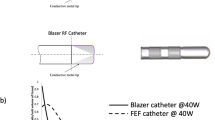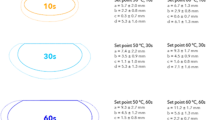Abstract
Background: Radiofrequency (RF) lesion size in vitro is positively correlated with applied power and catheter tip temperature. However, the relation between RF lesion size, power, and tip temperature in vivo remains unclear. We hypothesized that due to flow, anatomy and tip contact effects in vivo, increased tip temperature would be inversely related to applied power and RF lesion size.
Methods: RF lesions were created on the endocardium of 16 pigs using 5, 6, and 7 Fr catheters. The ablation generator was set to achieve a temperature of 70°C. RF lesions were created in different regions of the heart so as to encompass a wide range of blood flow and catheter movement conditions. RF lesions were measured acutely (DIMEN, mm) and correlated with average power applied (POWER, W), and average tip temperature (TEMP, °C). The POWER and TEMP relation was also examined.
Results: For TEMPs below 55°C, the power output from the generator was typically maximized at 50 W. At TEMPs above 55°C, POWER decreased exponentially with increasing TEMP {POWER = 50 – exp(-((41-TEMP)/7)), r = 0.98, p < 0.05}. Further, DIMEN tended to be inversely related to TEMP (Slope: −0.07 ± 0.04, r = −0.15, p = 0.07); but, was positively related to POWER (Slope: 0.04 ± 0.02, r = 0.23, p < 0.05). These relations varied by tip size and estimated local blood flow characteristics.
Conclusion: In vivo, variable tissue contact and flow yield DIMEN-POWER-TEMP relations opposite to those found in vitro. These counterintuitive results suggest that maximum in vivo RF lesion size is achieved when power is maximized at tip temperatures between 50 and 60°C.
Similar content being viewed by others
References
Haines DE, Verow AF. Observations on electrode-tissue interface temperature and effect on electrical impedance during radiofrequency ablation of ventricular myocardium. Circulation 1990;82:1034–1038.
Haines DE, Watson DD. Tissue heating during radiofrequency catheter ablation: A thermodynamic model and observations in isolated perfused and superfused canine right ventricular free wall. Pacing Clin Electrophysiol 1989;12:962–976.
Saul JP, Hulse JE, Papagiannis J, Van Praagh R, Walsh EP. Late enlargement of radiofrequency lesions in infant lambs. Implications for ablation procedures in small children. Circulation 1994;90:492–499.
Wittkampf FH, Hauer RN, Robles de Medina EO. Control of radiofrequency lesion size by power regulation. Circulation 1989;80:962–968.
Nakagawa H, Yamanashi WS, Pitha JV, Arruda M, Wang X, Ohtomo K, Beckman KJ, McClelland JH, Lazzara R, Jackman WM. Comparison of in vivo tissue temperature profile and lesion geometry for radiofrequency ablation with a saline-irrigated electrode versus temperature control in a canine thigh muscle preparation. Circulation 1995;91:2264–2273.
Petersen HH, Chen X, Pietersen A, Svendsen JH, Haunso S. Lesion dimensions during temperature-controlled radiofrequency catheter ablation of left ventricular porcine myocardium. Impact of ablation site, electrode size, and convective cooling. Circulation 1999;99:319–325.
Kongsgaard E, Foerster A, Aass H, Amlie JP. The effect of temperature-guided radiofrequency ablation of ventricular myocardium. Eur Heart J 1993;14:852–858.
Nath S, DiMarco JP, Haines DE. Basic aspects of radiofrequency catheter ablation. J Cardiovasc Electrophysiol 1994;5:863–876.
Lesh MD, Kalman JM, Karch MR. Use of intracardiac echocardiography during electrophysiologuc evaluation and therapy of atrial arrhythmias. J Cardiovasc Electrophysiol 1998;9(8 Suppl):S40–S47.
Callans DJ, Ren JF, Narula N, Michele J, Marchlinski FE, Dillon SM. Effects of linear, irrigated-tip radiofrequency ablation in porcine healed anterior infarction. J Cardiovasc Electrophysiol 2001;12:1037–1042.
Cao H, Vorperian VR, Tungjitkusolmun S, Tsai JZ, Haemmerich D, Choy YB, Webster JG. Flow effect on lesion formation in RFcardiac catheter ablation. IEEE Trans Biomed Eng 2001;48:425–433.
Langberg JJ, Gallagher M, Strickberger SA, Amirana O. Temperature-guided radiofrequency catheter ablation with very large distal electrodes. Circulation 1993;88:245–249.
Petersen HH, Chen X, Pietersen A, Svendsen JH, Haunso S. Temperature-controlled radiofrequency ablation of cardiac tissue: An in vitro study of the impact of electrode orientation, electrode tissue contact pressure and external convective cooling. J Interv Card Electrophysiol 1999;3:257–262.
Author information
Authors and Affiliations
Corresponding author
Rights and permissions
About this article
Cite this article
Mukherjee, R., Laohakunakorn, P., Welzig, M.C. et al. Counter Intuitive Relations Between in vivo RF Lesion Size, Power, and Tip Temperature. J Interv Card Electrophysiol 9, 309–315 (2003). https://doi.org/10.1023/A:1027426907668
Issue Date:
DOI: https://doi.org/10.1023/A:1027426907668




